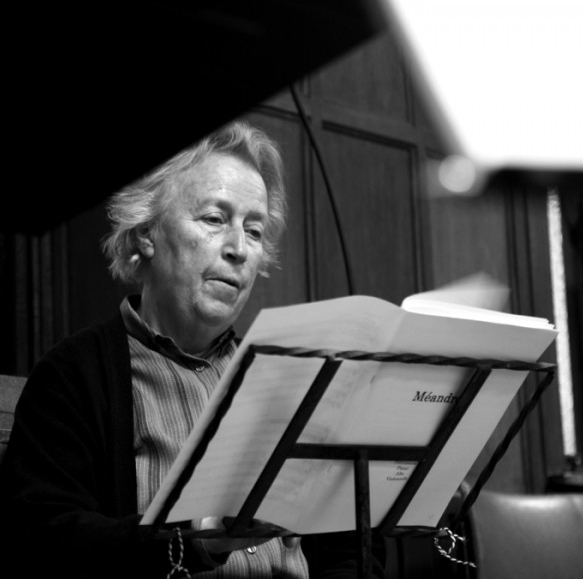Women composers shine in Juilliard’s “Trailblazers”-themed Focus Festival

While we are patting ourselves on the back about the present era’s (very gradual) leveling of the playing field for women who compose music, sooner or later we have to confront the fact of less level times. That’s why they call it “classical” music; for fans, the past is never dead. It’s not even past.
At the same time, the awful winnowing of memory means that a mere handful of composers get to be remembered even one generation later, never mind centuries. With a moved-back starting line, and family obligations and social stigma clinging to their skirts, it’s a wonder any women ever placed in this race.
So besides justice for today’s talent, there is a case for reparations to be made. Conductor Joel Sachs began making it Friday night in the Juilliard School’s Peter Jay Sharp Theater, with the first of six concerts in Focus Festival 2020, this year’s edition of the Juilliard School’s annual festival, with the overall title “Trailblazers: Pioneering Women Composers of the 20th Century.”
Sachs shared festival organizing and annotating duties with the Cuban-American composer and conductor Odaline de la Martinez, whom he credited with greatly expanding his list of possible composers for this festival’s programs. She joined him onstage Friday for a few words of welcome and of support for composers, whatever their sex or nationality.
In the concert, Sachs led a first-rate group of student musicians, the New Juilliard Ensemble, in chamber music by five women who, each in her own way, expressed the spirit of mid-century Modernism with skill and imagination.
Born in Belgium in 1930 and still living there, Jacqueline Fontyn was the youngster of the group, and her septet Méandres (Meanderings) of 2009-10 was by far the most recent piece on Friday’s program. The veteran of old-school Modernism showed she had an ear for 21st-century sounds as well, as flute, clarinet, strings, piano and percussion pieced together a delicate quilt of trills, bits of melody, triangle sparkles and soft gong strokes.
The prominence of percussion in three of Friday’s five pieces marked these composers — the earlier ones at least — as innovators. One New Juilliard Ensemble member in particular on Friday, the imaginative and unabashed percussionist/timpanist Sae Hashimoto, made an outsized contribution to the evening’s expressive landscape.
Although Ursula Mamlok (1923-2016) began and ended her days in Berlin, she was a notable figure in American music for much of her life. Her Girasol (Sunflower) of 1995 — for the same instruments as the Fonteyn, minus percussion — turned this way and that, just like its namesake, in a colorful, often whimsical set of variations on a walking theme.
Ohio-born Ruth Crawford (1901-1953) had already made quite a name for herself in the avant-garde circles of Chicago, New York, and Berlin before she married the composer and theorist Charles Seeger in 1931. Devoting the rest of her short career largely to Depression- and wartime-era folksong collecting, she left behind a small body of compositions that used exceptionally advanced techniques for their time.
Crawford’s interest in Sprechstimme voice technique and spatial arrangement of players came to the fore Friday in Three Songs to Poems by Carl Sandburg, composed in 1930-32. Backed — way back — by a small chamber orchestra far upstage, a concertino group of singer, oboe, piano and percussion captured the gritty urban sensibility of Sandburg’s “Rat Riddles” and “Prayers of Steel,” and the twisty bee trails of “In Tall Grass.” Soprano Britt Hewitt’s ratty sneer and steely delivery said it all.
Born into a prominent British artistic family, Elisabeth Lutyens (1906-1983) went all in for Webernian serialism in the 1930s, then waited until musical tastes in the U.K. caught up with her in the 1960s. Her Six Tempi for Ten Instruments of 1957 dealt mostly in micro-gestures — a sigh here, a bit of a song there, often with just one or two of the instruments speaking at a time — and the “tempi” occupied a narrow range between adagio and a sprightly allegretto in the closing section.
For all that, the ensemble of strings, winds, horn, trumpet and piano managed quite a variety of sounds and textures, unfailingly expressive under Sachs’s attentive, precise conducting. The music may have been hardcore serial, analytically speaking, but it certainly wasn’t hard-hearted.
Galina Ustvolskaya (1919-2006) was a protégée of Shostakovich — he literally protected her from the ire of Stalin’s arts authorities as she pursued a non-Socialist aesthetic of tender emotion and dissonant rage. Although she composed her Octet in 1949-50, its deep sighs and scary marching rhythms were not heard publicly in the U.S.S.R. until the slightly more liberal days of 1970.
In the five concise movements of Friday’s performance, the high timbres of four violins and two oboes shimmered and grated against piano bell-chords. Timpani grew ever more prominent until they closed the piece with fortissimo rat-a-tat blasts — making it clear that, although their fame may need a boost now and then, women composers can be plenty assertive on their own.
The Focus Festival 2020 continues through Jan. 31, next with solo and chamber music by Rebecca Clarke, Ruth Schonthal, Verdina Shlonsky, Barbara Pentland, Liu Zhuang and Elizabeth Maconchy 7:30 p.m. Monday, at Juilliard’s Peter Jay Sharp Theater. Free tickets at juilliard.edu; 212-799-5000.